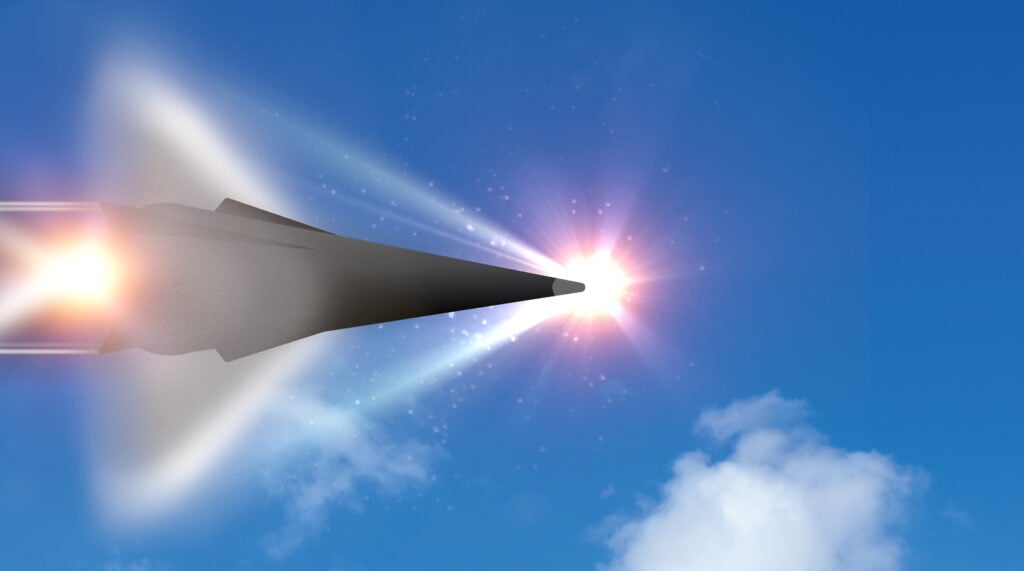
Dynetics concept for their Common Hypersonic Glide Body (C-HGB)
AUSA: The Army has unveiled an ambitious four-stage plan to modernize itself completely by 2035. That means new technology, new kinds of combat units, and, trickiest of all, a new approach to cultivating its people’s talents.
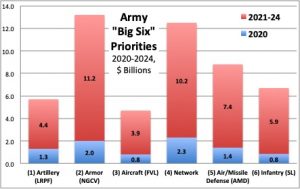
LRPF: Long-Range Precision Fires. NGCV: Next-Generation Combat Vehicle. FVL: Future Vertical Lift. AMD: Air & Missile Defense. SL: Soldier Lethality. SOURCE: US Army. (Click to expand)
But in the here and now, as many as 118 Army programs are on hold while Congress struggles to pass authorization and appropriations bills for the fiscal year that began two weeks ago. The Pentagon is currently operating under a stopgap measure called a Continuing Resolution, which (with rare exceptions) allows agencies to continue spending at last year’s levels, but not to start any new programs or grow existing ones. (Cuts are banned as well). That could disrupt the plan by delaying development of key weapons, like long-range hypersonic missiles, that the Army wants to field in the next few years.
The chief of the year-old Army Futures Command, Gen. John “Mike” Murray,” told reporters here this morning that the service had done everything it could to anticipate the current gridlock — there’ve been CRs of some duration every year from 1998 to 2018 — but the longer it continues, the greater the damage. “It would be easier to list the programs that won’t be affected,” he said.

Gen. John Murray, first chief of Army Futures Command, speaks at its formal activation in Austin.
34 Programs, 16 Years, 4 Phases
The new Army Modernization Strategy – a 12-page public document plus roughly 250 pages of Army-only implementation plans – pulls together a lot of ideas, programs, and dates we’ve reported on previously, such as the Big Six priorities and the focus on great powers. But it’s the first time we’ve seen everything in one succinct package and tied to such a clear timeline.
While 16 years is long enough for everyone involved today to have retired, the plan does have deliverables in the next three years for which the Army can be held accountable. In fact, technically, the countdown to 2035 has already started, because Fiscal Year 2020 – the first year of Phase I — began on Oct. 1st. (We gave the phases numbers and names in our summary below, since the Army document lacks them).
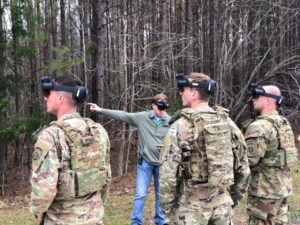
Soldiers train with the IVAS augmented-reality headset at Fort Pickett.
Phase I, 2020-2022: First Fielding
The Army will “begin initial fielding” of its 34 top-priority programs. That’s a number in flux. The service listed 31 in its ’20 budget, from long-range missiles to wireless networks to targeting goggles, but with the subsequent creation of a high-priority Program Executive Office to work on hypersonic weapons, directed energy (e.g. lasers), and space programs, Army officials often add those three as well. And the service has said programs that fail may get cut from the list, while new and promising weapons might get added.
The most prominent example of these near-term technologies: a set of goggles known as IVAS (Integrated Visual Augmentation System) that project a targeting cross-hairs, compass directions, and other tactical data over a soldier’s field of vision as desired. IVAS is supposed to enter service in 2021 – but skeptics in Congress have proposed steep cuts in prototyping funds for the program of which IVAS is a part, the Synthetic Training Environment (STE).
Alongside the equipment, and informing its development, the Army will continue testing its concept for future conflict, Multi-Domain Operations. The focus of this effort is field exercises by new units called Multi-Domain Task Forces, one of which is already at work in the Pacific and a second of which has just stood up in Europe, Gen. Murray said today.
Meanwhile, the Army will also “begin adjusting its global force posture.” That means not only creating new units like the MDTFs but potentially changing where forces are deployed to better deter Russia and Chinese aggression.
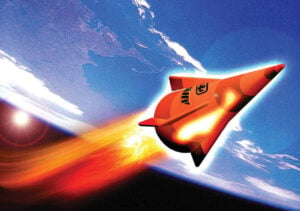
Sandia National Laboratories glide vehicle, the ancestor of the new Army-built Common Hypersonic Glide Body
Phase II, 2023-2025: Rearm & Reorganize
The Army begins reorganizing units across the force to execute the new Multi-Domain tactics and incorporate the new equipment that will start entering production.
This is the time period when the Army wants to start large-scale use of the VR simulations and augmented reality tools developed by the Synthetic Training Environment, which (as we mentioned above) Congress wants to cut in ’20.
This is also the period when the Army’s highest-priority weapon, its land-based Long-Range Hypersonic Weapon, is supposed to entire service with a prototype battery of missile launchers. But fielding an all-new weapon by 2023 depends on getting work underway ASAP.
The Army awarded two key hypersonics contracts at the end of FY 19 to avoid getting stuck in the 2020 gridlock. “We anticipated there would be a CR, so we think we’re in a really good position until around the first of the year,” the Program Executive Officer, Lt. Gen. Neil Thurgood, told reporters today. But if the Continuing Resolution extends beyond Jan. 1 – and there’s talk on the Hill of making it last all year – Thurgood says he’ll have to start delaying parts of the program to preserve its core elements.
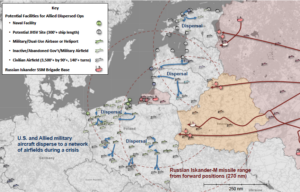
Defense of the Baltic States and Poland against a notional Russian missile barrage. (CSBA graphic)
Phase III, 2026-2028: Ready For Russia
Production begins on some of the biggest and most expensive Army programs. That includes the replacement for the M2 Bradley, the new Optionally Manned Fighting Vehicle – a program which is currently down to only one competitor after all the others were disqualified or dropped out. It also includes a new aerial scout to replace the retired OH-58 Kiowa, the Future Attack Reconnaissance Aircraft – for which there is a lively competition with five entrants of varying sizes.
These new weapons will go into new and redesigned units at every level, from individual combat brigades – the focus of fighting during Afghanistan and Iraq – to newly created four-star Field Armies in crucial theaters. By 2028, “the Army will certify the first MDO force package and begin building the next one.”
That means the Army will have enough modernized forces to conduct large-scale Multi-Domain Operations against one great-power adversary in one theater of war. While the strategy doesn’t specify the theaters outright, it makes clear elsewhere that Russia is the “pacing threat” and the “most capable… in the near term,” while China is a larger but longer-term problem. So we can predict with confidence that the first force package will be tailored to a land war in Europe, defending vulnerable allies like the Baltic States against Russia.

Graphic courtesy Sen. Dan Sullivan
Phase IV, 2029 2025: Ready For China
“During this period,” the strategy says, “the Army will finish certifying the next force package” – which we can safely assume will be one optimized for a naval war in the West Pacific against China. While many of the vital technologies will be the same, such as a command-and-control network resistant to hacking and jamming, the mix of forces will certainly be different – fewer tanks and more ultra-long-range missiles, for example. The role of the Army in the Pacific is also a supporting one to the Navy and Air Force, like an anvil to a pair of hammers. By fortifying islands with land-based firepower, the Army aims to keep Chinese ships and planes at bay, imposing casualties and constraining their maneuver so the other services can crush them on the high seas.
But modernization does not end here, the strategy document and Army leaders emphasize. “While this AMS outlines an end state for the future Army in 2035, Army modernization will remain ongoing,” the document says, “as we must continue to test and refine operating concepts, draw on emerging technologies, and anticipate changes in the operating environment.”
“We’re in a hole right now,” Gen. Murray told the AUSA conference this morning, relying on much-upgraded 40-year equipment from the Reagan buildup. The Army must not do another burst of modernization and then stop, he said, because “we’ll find ourselves in another hole in 30 years.” The Army, he said, must become ‘a persistently modernizing organization.”
2019 Army Modernization Strategy_Final by BreakingDefense on Scribd























